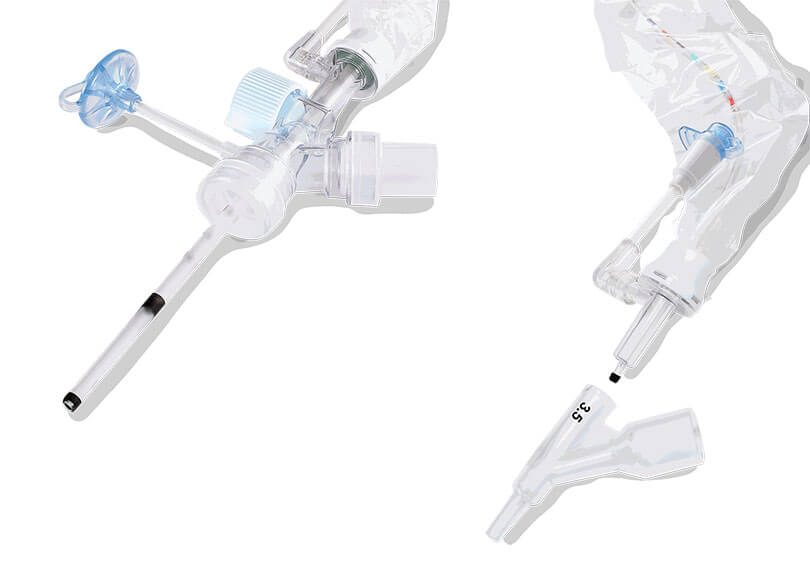Closed vs. Open Suction Systems: Clinical Benefits and Cost Comparison

Effective airway management is a cornerstone of critical care, particularly for mechanically ventilated patients. Suctioning plays a vital role in maintaining airway patency, clearing secretions, and minimizing the risk of infection. Clinicians typically rely on two primary approaches: the open suction system (OSS) and the closed suction system (CSS), each offering distinct clinical benefits, limitations, and cost considerations.
A clear understanding of the differences between these suctioning techniques enables healthcare professionals to make evidence-based decisions that enhance patient safety, improve infection control, and promote cost-efficient care. Key factors to consider include oxygenation maintenance, staff and patient safety, infection prevention, and overall cost-effectiveness.
What Is an Open Suction System (OSS)
An open suction system requires temporary disconnection of the patient from the ventilator. A sterile suction catheter is inserted into the endotracheal or tracheostomy tube to remove secretions. After suctioning, the patient is reconnected to the ventilator.
Key Characteristics:
- Single-use suction catheter, discarded after each use.
- Ventilator disconnection increases risk of hypoxemia.
- Requires strict aseptic technique.
- More nursing time is typically needed.
OSS remains widely used in many healthcare settings because of its lower upfront cost and simplicity. However, its limitations become critical in vulnerable patients who cannot tolerate interruption in oxygenation.
What Is a Closed Suction System (CSS)
A closed suction system involves a suction catheter enclosed within a sterile sheath that stays attached to the ventilator circuit. The patient is not disconnected during the procedure, allowing continuous oxygenation and ventilation.
Key Characteristics:
- Multiple-use catheter system, typically replaced every 24–72 hours.
- Maintains FiO₂ and PEEP during suctioning.
- Reduces exposure of staff to patient secretions.
- Easier to perform suctioning in unstable or highly infectious patients.
CSS is increasingly preferred in intensive care units, especially for patients on long-term ventilation, those at high risk of infection, or those requiring frequent suctioning.
Difference Between Open and Closed Suctioning
1. Oxygenation Maintenance
- Open Suction System (OSS): Because the ventilator is disconnected, oxygenation and positive end-expiratory pressure (PEEP) are interrupted. This can lead to desaturation, hypoxemia, or hemodynamic instability.
- Closed Suction System (CSS): Maintains oxygenation and ventilation during suctioning, significantly reducing the risk of hypoxemia.
For critically ill patients, especially those with acute respiratory distress syndrome (ARDS), CSS provides a major safety advantage.
2. Safety for Patients and Staff
- OSS: Disconnection exposes staff to aerosolized secretions, increasing infection risk. Patients may experience cardiovascular instability due to sudden oxygen desaturation.
- CSS: Reduces secretion exposure for staff and maintains stable patient physiology during suctioning.
In the era of airborne infectious diseases such as COVID-19, CSS offers better protection for healthcare workers.
3. Infection Control
- OSS: Each procedure introduces risk of contamination since a new catheter is used. Disconnection from the ventilator circuit increases the chance of pathogens entering the airway.
- CSS: Designed for repeated use within a sterile sheath, reducing contamination risk. Studies suggest CSS lowers the incidence of ventilator-associated pneumonia (VAP).
For hospitals focusing on VAP prevention protocols, CSS aligns better with infection control standards.
4. Cost-Effectiveness
At first glance, open suctioning seems cheaper since each catheter costs less. However, a true cost analysis must consider the broader clinical and operational impact.
- OSS Costs: Lower per-catheter expense, but higher indirect costs due to staff workload, oxygen desaturation events, and higher VAP rates.
- CSS Costs: Higher initial catheter cost, but cost-saving in the long run through reduced complications, shorter ICU stays, and decreased antibiotic use.
For facilities treating high-risk, long-term ventilated patients, CSS often proves more cost-effective over time.
Advantages and Disadvantages at a Glance
|
Aspect |
Open Suction System (OSS) |
Closed Suction System (CSS) |
|
Oxygenation |
Interrupted, risk of hypoxemia |
Maintained, stable oxygenation |
|
Infection Control |
Higher contamination/VAP risk |
Reduced VAP risk, better infection prevention |
|
Staff Safety |
Higher exposure to secretions |
Lower exposure, safer in infectious cases |
|
Ease of Use |
Requires disconnection, more steps |
Quick, convenient, especially in emergencies |
|
Cost |
Lower upfront cost |
Higher initial cost, but long-term savings |
Choosing the Right Suction System
The choice between closed and open suction systems depends on the clinical context, patient condition, and hospital policies.
- Short-term ventilation / limited suctioning needs: OSS may be cost-effective if infection risk is low.
- Long-term ventilation / frequent suctioning: CSS offers significant advantages in oxygenation stability and infection prevention.
- High infection risk (ICU, COVID-19, VAP prevention protocols): CSS is the preferred method.
-
Resource-limited settings: OSS may remain practical due to lower upfront costs, but careful monitoring is essential.
Vitaltec’s Closed Suction System Solutions
At Vitaltec, we specialize in developing advanced Closed Suction Systems designed for optimal patient care and clinical efficiency. Our systems are engineered to:
- Maintain oxygenation and ventilation during suctioning.
- Reduce contamination risks with protective catheter sheaths.
- Support infection control efforts to minimize VAP incidence.
- Improve staff safety by reducing exposure to respiratory secretions.
Balancing Clinical Outcomes and Costs
The debate between closed vs. open suction systems is not only about immediate costs but also about long-term patient outcomes and institutional efficiency. While OSS may appear less expensive, the potential complications—hypoxemia, infection risk, longer ICU stays—can outweigh its short-term savings. CSS, though more costly upfront, provides clear advantages in safety, infection prevention, and overall cost-effectiveness.
Healthcare facilities focused on minimizing VAP incidence and enhancing patient safety are increasingly turning to closed suction systems. Choosing a trusted manufacturer like Vitaltec provides access to advanced, clinically validated airway management solutions designed to optimize patient outcomes while supporting efficient and safe hospital operations. Contact us today.
You May Also Be Interested In:
👉Ventilator-Associated Pneumonia (VAP) Infection Control Practices and Strategies
👉Understanding Ventilator-Associated Pneumonia (VAP) and Its Impact
